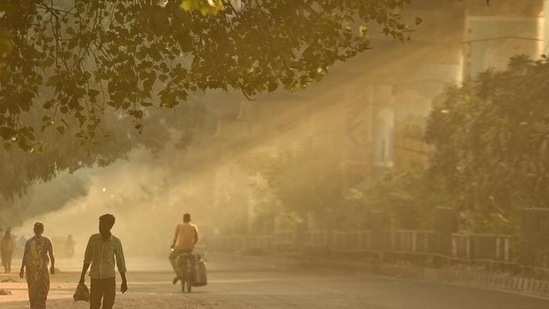Delhi faces key pollution fight as fires rise, mercury drops
The city recorded its lowest temperature of the season at 13.6°C on Monday morning – cold conditions cause winds to die down, trapping pollutants – and the number of farm fires in Punjab and Haryana crossed 3,000 on Sunday.
The cleanest October in years is likely to be followed by heavy air pollution days in November, weather experts have predicted, as the Capital faces its most crucial bad air challenge over the next two weeks with winter conditions setting in ahead of Diwali, and farm fire starting to surge in the neighbouring states of Punjab and Haryana.

The air quality index (AQI) on Monday was 281, in the same range as the 289 the day before. The city recorded its lowest temperature of the season at 13.6°C on Monday morning – cold conditions cause winds to die down, trapping pollutants – and the number of farm fires in Punjab and Haryana crossed 3,000 on Sunday.
The Capital breathes its most polluted air between November 1 and November 15, when the smoke from stubble fires and illegal firecrackers plunge the city into a health emergency, a Delhi government analysis of average PM2.5 (particulate matter with diameter less than 2.5 micrometres) levels over the last five years showed.
Though firecrackers are banned in the Capital, their illegal use during the festival (November 4 this year) leads to a peak in pollution levels, with people breathing poisonous air amid a thick blanket of smog.
Experts also warned that, till now, Delhi has benefitted from south-easterly winds not typical for this time of the year but that could change around Diwali when toxic emissions form firecrackers is also expected to linger in the air.

“Temperatures have dropped and this was the coldest morning of the season so far, but a change in wind direction has helped as emissions from stubble burning are not reaching Delhi completely. The minimum is expected to be around 15 degrees Celsius for the next couple of days and wind directions will primarily stay easterly and south-easterly,” said a meteorological department official, asking not to be named.
The change to north-westerly winds is likely around November 4.
According to the System of Air Quality and Weather Forecasting And Research (SAFAR), a body under the ministry of earth sciences, the contribution of stubble burning in Delhi’s overall PM 2.5 concentration was just 7% on Monday, down from 8% on Sunday and 12% on Saturday. According to Safar’s estimates, there were 3,971 farm fires in and around NCR – in Punjab and Haryana, according to data accessed by HT, Nasa satellites recorded 3,140 farm fires.
Fires in these areas particularly impact Delhi since they lie upwind when the direction of north-westerly.
Anumita Roy Chowdhury, executive director, research and advocacy at the Centre for Science and Environment (CSE) says more farm fires are expected in November now, as farmers will get a shorter window to clear their fields and plant the next crop. “Rains which have continued till late October have disrupted the burning pattern too and it is possible we may record incredibly high farm fire counts in a short period,” she said.
Delhi recorded a maximum temperature of 31.2°C on Monday – one degree above normal, while the minimum was of 13.6°C, two notches below normal. Ayanagar was the coldest location across Delhi, recording a minimum of 13 degrees.
Another forecasting system – the Early Warning System (EWS) for Delhi meanwhile predicted air quality is expected to deteriorate slightly in the next 48 hours, with a possibility of touching the ‘very poor’ category.
“Air quality over Delhi is likely to remain in the ‘poor’ category on Monday and be between ‘poor’ and the lower end of the ‘very poor’ category on Tuesday and Wednesday. For the subsequent five days, air quality is expected to deteriorate by November 5 and 6 and may reach upper end of the ‘very poor’ category, with PM 2.5 to be the pre-dominant pollutant,” it said.
Grap, a set of emergency measures approved by the Supreme Court in 2016, kicks in from October 15 and continues to be in force till March 31 depending on the air quality of the region. It lists out a set of institutionalised measures to be taken when air quality deteriorates and reaches a certain level.
Stay updated with all top Cities including, Bengaluru, Delhi, Mumbai and more across India. Stay informed on the latest happenings in World News along with Delhi Election 2025 and Delhi Election Result 2025 Live, New Delhi Election Result Live, Kalkaji Election Result Live at Hindustan Times.
Stay updated with all top Cities including, Bengaluru, Delhi, Mumbai and more across India. Stay informed on the latest happenings in World News along with Delhi Election 2025 and Delhi Election Result 2025 Live, New Delhi Election Result Live, Kalkaji Election Result Live at Hindustan Times.





